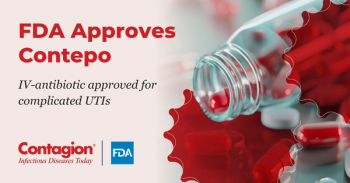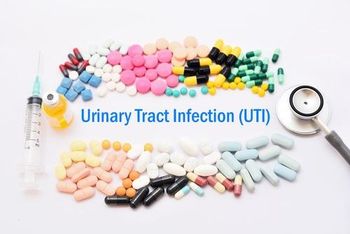
- February 2020
- Volume 5
- Issue 1
Bacteriophage-Antibiotic Combinations: A Promising Alternative for Refractory Infections?

Despite the initial abandonment of bacteriophages in most areas of the world, the era of antibiotic resistance has led to a resurgence of phage therapy in clinical practice.
The constant increase of multidrug-resistant (MDR) organisms has led to an unavoidable decline of effective antimicrobials. Despite a resurgence of the antibiotic pipeline in recent years, the discovery of novel therapeutic targets remains limited.1 Obligately lytic bacteriophages (phages) are viruses that target, infect, and kill bacterial cells.2 As multiple reports have shown that phages used in combination with antibiotics could lead to improved efficacy (eg, phage-antibiotic synergy, resensitization of antibiotic therapy, etc), this therapeutic strategy could be a rational method to battle the antibiotic resistance currently facing clinicians.3-6
INTRODUCTION TO BACTERIOPHAGES
Phage therapy was first implemented in the early 20th century, but the introduction of antibiotics, among other factors, overshadowed their therapeutic potential throughout the majority of the world.7,8 Despite this initial abandonment, the era of antibiotic resistance has led to a resurgence of phage therapy into clinical practice, primarily in refractory cases or to attack MDR organisms.2,3,8-9 Phages depend on their bacterial hosts for replication, and the 2 main life cycles for viral replication are the lytic, or virulent cycle (in which the phage kills the bacterial cell) and the lysogenic, or temperate cycle (in which the phage lays dormant within the bacterial genome and does not immediately kill the bacterial cell). In clinical practice, lytic phages are favored for use.10,11
Most phages used for therapy are viruses that consist of DNA within a prism-shaped head, spikes/tail fibers that attach to bacteria, and a tail sheath through which the DNA flows en route to injecting its host.11 The interaction of virulent phages and bacteria begins with the tail fibers of the phages adsorbing to their specific receptors on the surface of the bacteria. Following attachment, phages create a hole on the bacterial surface to propel their DNA through their tail sheath into the bacterial cytoplasm. The function of the DNA from the phages is to take over the bacterial host’s bacterial machinery to replicate and produce new phages within the bacterial cell. This process continues until the bacterial cell is lysed, at which point the phage offspring are released to reinitiate the cycle.10,11
Importantly, the use of “phage cocktails”—or combinations of phages—is typically recommended for therapy, although monophage therapy is sometimes employed. Because single phage activity is typically very specific, utilizing phage cocktails broadens the antibacterial activity. It has also been shown to reduce the development of phage-resistant bacteria.12-14
POSITIVE INTERACTIONS AGAINST BACTERIA WITH PHAGE-ANTIBIOTIC COMBINATIONS
Phages used alone have potential advantages over antibiotics. These include high specificity to bacteria, which limits potential damage to the normal flora of the host; self-limiting action, meaning that phage numbers decline as the bacterial infection resolves; and phages’ adaptability with the bacterial host, in that they may infect previously phage-resistant bacterial mutants. However, recently published research has shown promising results with phage-antibiotic combinations against bacteria.3-6,10,11,13 Currently, phage-antibiotic combinations seem to be particularly important when there are minimal or no antibiotic options due to antibiotic resistance, or in instances when there is minimal diffusion of antibiotic(s) to the infected area of interest. At present, phage therapy in place of antibiotics in critically ill patients is highly unlikely to occur until more evidence of efficacy through controlled studies becomes available. Although numerous positive interactions have been reported with phage-antibiotic combinations, selected interactions dealing with enhancement, with brief examples, are described below.
1. Phage-antibiotic synergy (PAS) and reductions in bacterial growth or reductions in minimum inhibitory concentrations (MIC)
Comeau and colleagues coined the phrase PAS in describing how sublethal concentrations of antibiotics may stimulate the production of virulent phages. The investigators evaluated phage fMFP against Escherichia coli (strain MFP) with and without cefotaxime. The presence of cefotaxime at a concentration of 50 ng/mL exhibited a marked PAS effect that was not observed in the absence of cefotaxime.4 Another study performed by Oechslin and colleagues evaluated phage cocktail PP1131 and various antibiotics against Pseudomonas aeruginosa. Within their in vitro analysis of static fibrin clots, meropenem and ciprofloxacin at 2.5x MIC in combination with phage cocktail PP1131 was associated with ≥3 log10 colony forming units/mL bacterial reduction when compared with monotherapy with either antibiotic or phages.5
2. Biofilm eradication
Biofilms are polysaccharide matrices that shield pathogens from antibiotics and the host immune system. Phages can produce enzymes, such as depolymerases and endolysins, that can expedite the breakdown of the extracellular matrices of biofilms.15 An in vitro biofilm analysis performed by Chaudhry and colleagues evaluated P aeruginosa (strain PA14) against monotherapy and combination therapy with 2 phages (NP1 and NP3) and various antibiotics. After biofilm growth occurred, synergistic activity was noted when a combination of the phages and antibiotics was present; this activity occurred to a lesser degree when either agent was used alone.16
3. Alterations in the emergence of resistance
It has been shown that phages may impose a selective pressure on certain strains of bacteria. This “evolutionary trade-off ” may be associated with a fitness cost (fitness is the ability of an organism to survive in a competitive environment) of inducing phage resistance, but with regaining bacterial susceptibility to antibiotics.17 Ho and colleagues described an example of this phenomenon in which an epaR mutation led to a reduction in phage adsorption to a strain of Enterococcus faecalis (OG1RF); however, daptomycin susceptibility was enhanced in the presence of this mutation.18
There are fewer reports of clinical data than there are of in vitro data, but some clinical data have emerged from studies, with more to come. A report published by Schooley and colleagues describes the use of intravenous and intracavitary phage cocktail therapy to treat an MDR Acinetobacter baumannii infection. A 68-year-old man had an infection disseminated from pancreatic pseudocysts and necrotizing pancreatitis; he had received 2 intravenous phage cocktails and 1 locally administered phage cocktail, in combination with minocycline, This treatment led to clearance of infection and clinical improvement, in contrast to previous clinical deterioration after multiple rounds of source control and antibiotics.3 Other clinical reports have been described, in which phages have been used through compassionate use to complement the existing antibiotic arsenal in cases where traditional therapy with antibiotics had failed.9,19-24
Additionally, clinical trials are in progress examining the combination of phage endolysin and antibiotics. One trial already presented was a phase 2, placebo-controlled, double-blind, randomized clinical trial comparing Exebacase, formerly CF-301 (phage-derived endolysin) plus standard-of-care (SOC) versus SOC alone in patients with Staphylococcus aureus bacteremia. At day 14, higher clinical responder rates had occurred in the prespecified Methicillin-resistant S aureus subgroup analysis (~75% vs ~30%; P = .010).25
FINAL THOUGHTS
In this troubling era of antibiotic resistance, the use of bacteriophages in combination with antibiotics is a very promising therapeutic approach. Additional randomized controlled trials comparing SOC versus SOC in combination with phages or phage derivatives are urgently needed. Among the facets of treatment that must be studied are optimal administration route, duration of phage therapy, and whether antibiotic or phage treatment can be de-escalated while the other is continued. The long-term effects of increased phage use on antibiotic resistance are currently unknown and must be evaluated, too. These considerations could lead the way for a new focus on “phage stewardship.” Despite the many unanswered questions and the additional intricacy phages would bring to the already complicated scenario of treating patients suffering from infectious diseases (Figure), phage-antibiotic combinations may enhance effectiveness via multiple mechanisms. Further research is most certainly warranted.
Morrisette is a postdoctoral research fellow specializing in pharmacokinetics/ pharmacodynamics and health outcomes at Wayne State University in Detroit, Michigan. He completed his PGY-1 residency at Methodist University Hospital in Memphis, Tennessee, and his PGY-2 infectious diseases residency at the University of Colorado in Aurora. Kebriaei is a postdoctoral research fellow specializing in pharmacokinetics/ pharmacodynamics and biotechnology at Wayne State University in Detroit, Michigan. She has more than 10 years of experience in biotechnology, biological assay designs, detection techniques, and bioengineering/modeling. Morales is a microbiologist with more than 14 years of experience in bacteriophage science and specific doctoral training in bacteriophage therapy, with an emphasis on the preclinical and clinical development of bacteriophage-based products. Rybak is professor of pharmacy and medicine and director of the Anti-Infective Research Laboratory, Department of Pharmacy Practice, Eugene Applebaum College of Pharmacy & Health Sciences at Wayne State University. * indicates active members of the Society of Infectious Diseases Pharmacists+ indicates active members of the Making a Difference in Infectious Diseases Research Network
References:
- Boucher HW, Talbot GH, Bradley JS, et al. Bad bugs, no drugs: no ESKAPE! an update from the Infectious Diseases Society of America. Clin Infect Dis. 2009;48(1):1-12. doi: 10.1086/595011.
- Gordillo Altamirano FL, Bar JJ. Phage therapy in the postantibiotic era. Clin Microbiol Rev. 2019;32(2):e00066-18. doi: 10.1128/CMR.00066-18.
- Schooley RT, Biswas B, Gill JJ, et al. Development and use of personalized bacteriophage-based therapeutic cocktails to treat a patient with disseminated resistant Acinetobacter baumannii infection. Antimicrob Agents Chemother. 2017;61(10):e00954-17. doi: 10.1128/AAC.00954-17.
- Comeau AM, Tétart F, Trojet SN, Prère MF, Krisch HM. Phage-antibiotic synergy (PAS): beta-lactam and quinolone antibiotics stimulate virulent phage growth. PLoS One. 2007;2(8):e799. doi: 10.1371/journal.pone.0000799.
- Oechslin F, Piccardi P, Mancini S, et al. Synergistic interaction between phage therapy and antibiotics clears Pseudomonas aeruginosa infection in endocarditis and reduces virulence. J Infect Dis. 2017;215(5):703-712. doi: 10.1093/infdis/jiw632.
- Bedi MS, Verma V, Chhibber S. Amoxicillin and specific bacteriophage can be used together for eradication of biofilm of Klebsiella pneumoniae B5055. World J Microb Biot. 2013;25(7):1145-1151. doi: 10.1007/s11274-009-9991-8.
- Duckworth DH. “Who discovered bacteriophage?”. Bacteriol Rev. 1976;40(4):793-802.
- Kutter E, De Vos D, Gvasalia G, et al. Phage therapy in clinical practice: treatment of human infections. Curr Pharm Biotechno. 2010;11(1):69-86. doi: 10.2174/138920110790725401.
- Khawaldeh A, Morales S, Dillon B, et al. Bacteriophage therapy for refractory Pseudomonas aeruginosa urinary tract infection. J Med Microbiol. 2011;60(Pt 11):1697-1700. doi: 10.1099/jmm.0.029744-0.
- Wittebole X, De Roock S, Opal SM. A historical overview of bacteriophage therapy as an alternative to antibiotics for the treatment of bacterial pathogens. Virulence. 2014;5(1):226-235. doi: 10.4161/viru.25991.
- Lin DM, Koskella B, Lin HC. Phage therapy: an alternative to antibiotics in the age of multi-drug resistance. World J Gastrointest Pharamcol Ther. 2017;8(3):162-173. doi: 10.4292/wjgpt.v8.i3.162.
- Chan BK, Abedon ST, Loc-Carrillo C. Phage cocktails and the future of phage therapy. Future Microbiol. 2013;8(6):769-783. doi: 10.2217/fmb.13.47.
- Loc-Carrillo C, Abedon ST. Pros and cons of phage therapy. Bacteriophage. 2011;1(2):111-114. doi: 10.4161/bact.1.2.14590.
- Oechslin F. Resistance development to bacteriophages occurring during bacteriophage therapy. Viruses. 2018;10(7):E351. doi: 10.3390/v10070351.
- Abedon ST. Ecology of anti-biofilm agents I: antibiotics versus bacteriophages. Pharmaceuticals (Basel). 2015;8(3):525-558. doi: 10.3390/ph8030525.
- Chaudhry WN, Concepción-Acevedo J, Park T, Andleeb S, Bull JJ, Levin BR. Synergy and order effects of antibiotics and phages in killing Pseudomonas aeruginosa biofilms. PLoS One. 2017;12(1):e0168615. doi: 10.1371/journal.pone.0168615.
- Chan BK, Sistrom M, Wertz JE, Kortright KE, Narayan D, Turner PE. Phage selection restores antibiotic sensitivity in MDR Pseudomonas aeruginosa. Sci Rep. 2016;6:26717. doi: 10.1038/srep26717.
- Ho K, Huo W, Pas S, Dao R, Palmer KL. Loss-of-function mutations in epaR confer resistance to fNPV1 infection in Enterococcus faecalis OG1RF. Antimicrob Agents Chemother. 2018;62(10):e00758-18. doi: 10.1128/AAC.00758-18.
- Chan BK, Turner PE, Kim S, Mojibian HR, Elefteriades JA, Narayan D. Phage treatment of an aortic graft infected with Pseudomonas aeruginosa. Evol Med Public Health. 2018;2018(1):60-66. doi: 10.1093/emph/eoy005.
- Dedrick RM, Guerrero-Bustamante CA, Garlena RA, et al. Engineered bacteriophages for treatment of a patient with a disseminated drug-resistant Mycobacterium abscessus. Nat Med. 2019;25(5):730-733. doi: 10.1038/s41591-019-0437-z.
- Law N, Logan C, Yung G, et al. Successful adjunctive use of bacteriophage therapy for treatment of multidrug-resistant Pseudomonas aeruginosa infection in a cystic fibrosis patient. Infection. 2019;47(4):665-668. doi: 10.1007/s15010-019-01319-0.
- Aslam S, Courtwright AM, Koval C, et al. Early clinical experience of bacteriophage therapy in 3 lung transplant recipients. Am J Transplant. 2019;19(9):2631-2639. doi: 10.1111/ajt.15503.
- Nir-Paz R, Gelman D, Khouri A, et al. Successful treatment of antibiotic-resistant poly-microbial bone infection with bacteriophages and antibiotics combination. Clin Infect Dis. 2019;69(11):2015-2018. doi: 10.1093/cid/ciz222.
- Aslam S, Pretorius V, Lehman SM, Morales S, Schooley RT. Novel bacteriophage therapy for treatment of left ventricular assist device infection. J Heart Lung Transplant. 2019;38(4):475-476. doi: 10.1016/j.healun.2019.01.001.
- Fowler VG, Das A, Lipka J, Schuch R, Cassino C. Exebacase (Lysin CF-301) improved clinical responder rates in methicillin-resistant Staphylococcus aureus (MRSA) bacteremia including endocarditis compared to standard-of-care antibiotics alone in a first-in-patient phase 2 study. Presented at: 29th European Congress of Clinical Microbiology and Infectious Diseases; April 13-16, 2019; Amsterdam, Netherlands. Presentation L0012.
>>Read more Multidrug-Resistant Infections articles:
December 2019:
October 2019:
August 2019:
Articles in this issue
over 5 years ago
Oseltamivir on the Move, but Where Should It Go?over 5 years ago
Diagnostic Stewardship: Beyond Managing Bloodstream Infectionsover 5 years ago
Never Ignore a New Rash in a Patient With AIDSover 5 years ago
Imipenem-Cilastatin-Relebactam: Imipenem Is Rele Back Againalmost 6 years ago
Clinical Characteristics of the First 2019-nCoV Cases in Wuhan, ChinaNewsletter
Stay ahead of emerging infectious disease threats with expert insights and breaking research. Subscribe now to get updates delivered straight to your inbox.

































































































































































































































































































